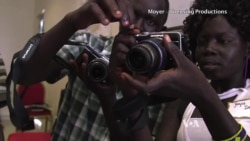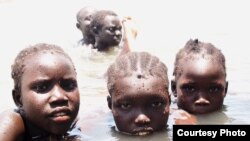The images on display at National Geographic headquarters in Washington were global, yet intimate - two friends embracing, a baby sleeping blissfully in its mother's arms, men setting out fishing nets, a lone seamstress in front of a sewing machine. The pictures help tell the stories of members of the community; of family bonds and friendship, work and community, love and survival.
They were taken by aspiring young photographers who participated in a special photography mentoring program set up by National Geographic, one of the largest nonprofit scientific and educational institutions in the world.
Catherine Simon Arona is one of 20 young adults from South Sudan - the world’s newest nation - who took part in a class this past September.
“Joining the photo camp meant a lot to me because it gave me a sense of thinking about a photo in a very different way,” she said. “The news gives a small perspective of the wide picture of what South Sudan is. Humanizing the life in South Sudan is what my heart wants to do, and through my camera I can easily do that.”
Catherine and two other South Sudanese students were in Washington recently to participate in a panel discussion, learn more about National Geographic and share their camp experience.
They also had the opportunity to educate Americans about their country. Catherine related a conversation with a waitress who served the group breakfast.
"[She] asked us where we were from and when I said I was from South Sudan, she said, ‘oh, how is the war over there?’ and I was like, seriously?”
“I have a life, I take pictures, I’m happy,” Catherine told her. “We have markets, there are parties, we have weddings,” she added. “Yes, there is war, but there is also life.”
Currently a law student in Juba, the capital, Catherine says she can see how photography can also be used as a tool for legal purposes.
“When I take pictures of things I don’t like in society, I will be able to present those pictures,” she said.
A dozen years of storytelling through pictures
Kirsten Elstner, a former freelance photographer with The New York Times, started the workshops in 2003, and still directs the program.
“Our mission is to give young people a voice to tell their own stories through photography and through the mentoring process of working through a National Geographic photo camp workshop,” she explained. “Because they live there and it’s their home and their community and their neighborhood and their lives. That’s the whole point of the program.”
Last year's photo camp in South Sudan was funded by USAID. The students were encouraged to document the ways that citizens of the new country are engaging in development and peace-building activities.
Internews, an international non-profit organization whose mission is to empower local media worldwide, worked with them by arranging photo shoots in a refugee camp, an orphanage, and a kickboxing youth training center that works to channel young energy into martial arts.
Experienced National Geographic professionals worked closely with the students, providing basic photography training and hands-on instruction, both in and out of the classroom.
Catherine's assignment, at the orphanage, resulted in a series of photographs, including her favorite, of a sad little boy.
“I love that picture so much,” she said, “because it’s a moment, and it has that emotion of a child… How they feel inside is what they show on their faces….I love taking those moments.”
Duku Stephen Savio, 24, is a journalism student at the University of Juba. He spoke passionately about his assignment, which was to photograph local kickboxers preparing for a competition.
He recalled that one of the boxers was wearing shorts with a flag of South Sudan on one side and an American flag on the other, and says he knew right away that he wanted to capture that image.
“I need[ed] to tell a story about that picture because United States…they put pressure on the Sudan government to let us have our independence,” he said, adding, “that was very important for me.”
Duku was inspired to see the kickboxers, from different tribes, coming together in friendly competition. He hopes his photographs reflect that feeling of comraderie and will inspire local youth to seek alternatives to a life of violence.
“Our young boys these days have joined [the] conflict. They have joined military wings, joined the military to fight their own brothers, and it’s important to bring them together in peace and harmony [to] fight for peace,” he said.
“The camera has become my best friend,” said Akuot Chol Mayak, a Communications major who plans to become a professional journalist. He welcomed his assignment at a local refugee camp, because he said he could identify with his subjects.
“I grew up as a refugee in a refugee camp in northern Kenya," he explained, "and when I went there, it reflects back to how I was and my soul was with them.”
Akuot is grateful for what he learned at the photo camp and says he plans to share that knowledge with his friends and colleagues back home.
Personal connections
During their visit to Washington, the students visited the archives division at National Geographic where they viewed photographs taken in what is now South Sudan from the 1920s. Elstner believes they suddenly realized the relevance and value of what they are doing today.
“They thought ‘Well, the pictures I’m taking now, someone will look at these in the future and look back and say this is when South Sudan became a new nation - those were the formative years in South Sudan - and our pictures will show what people looked like, what people were doing, what people were thinking about at that time,’ and that was really exciting for them,” she said.
National Geographic is planning more photo camps throughout the United States and around the world in the coming years.










